|
|
Canoe Chair Construction
|
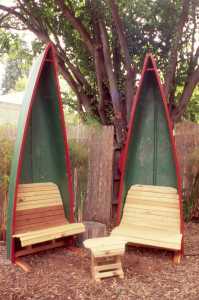
In May of 2009 our friend and neighbor Peter had a dilemma, one that I was in a unique position to solve. He had an old canoe made from ¼" thick PVC, with a tubular aluminum frame, that he wanted to get rid of. He’d tried selling it at a yard sale but it didn’t move, even though it was totally functional as a canoe. If it had been a sit-on-top ocean canoe I would have jumped on it for diving but it was for lakes and rivers and was not dive friendly.
I said “If you really want to get rid of it, I’ll cut it in half and make chairs out of it”. Peter agreed and that is what I did. This is the story of making the Canoe Chairs.
|
|
The canoe was 17’ long, so I cut it in half. This is what it looked like after removing the internal aluminum framing and cutting it. I used a circular saw to cut it after spending ages measuring and drawing a cut line on the underside.
|
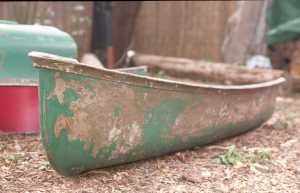
It had been painted a couple of times. Apparently a previous owner had been a hunter so there was a camo quality to its surface. I used a power washer to remove as much of the old surface as possible but couldn't get it all off. I decided to leave it with those imperfections because the effort and on-going maintenance of a painted surface didn't seem worth while, plus it seemed fine the way it was.
I sanded and painted the aluminum gunwale a solid red, contrasting with the green of the body and separating it from the (mainly) greens and browns of the yard.
|
|
The chairs are made of three parts: the Base; the Canoe Half; the Seat (which comprises the Seat Frame and the Seat Surface). The main design drivers were:
- There should be a solid Base sticking out the front to provide stability
- The Canoe Half is screwed to the Base but provides no structural integrity
- The Seat is bolted to the Base and could be replaced by a different piece of furniture if so desired
Here are a couple of shots of the Base, a “U” shaped piece made from some old style 2x4s, all pieces glued and screwed together then varnished. If you look closely at the varnished shot, you will see three holes which can be used for mounting bolts (to mount the Seat to the Base) or rebar to lock it to the ground. Note also the hanger bolts which can also be used to attach something to the Base but were not used for the Seats.
|
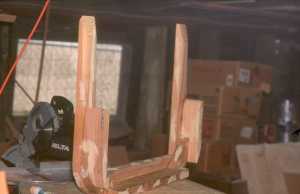
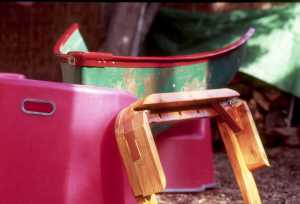
|
|
The Seat starts off with a solid 2x4 frame. The basic structure of the Seat is a sub-assembly like the first photo below, two 2x4s that cross and form the back and the seat. Each Seat has two of these sub-assemblies that are attached to a crossbar, which will end up sitting on the base.
|
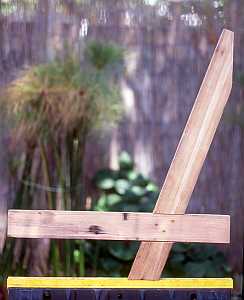
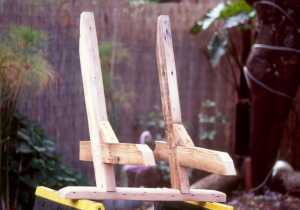
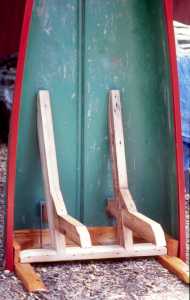
|
|
Metal connectors (Simpson Strong Ties) are used to connect the frame to the base, as can be seen in the following pictures. The first picture shows a connector attached to the frame. It was originally an “L” shaped connector which then had a second bend hammered into it. The third picture shows the base with two bolts visible, to which the frame is attached.
|
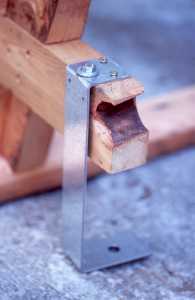
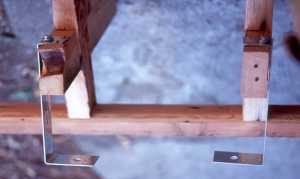
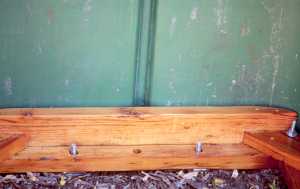
|
|
Two bolts tie the Seat to the Base, so it can easily be removed for transportation. This geometry allowed the seat to cantilever out so there’s no need for front legs, a successful design aesthetic.
Once the Seat Frame was built, it was bolted to the Base and the Seat Surface was applied. The Seat Surface is made from 2" to 3" wide slats cut from some Cedar Siding I had. They're not all the same width, as you can see, and were made by cutting a few, attaching them to the frame, then re-measuring for the next few.
Here are some shots of the finished chairs. There's also a foot stool made with the same design aesthetic - one day I'll make a couple more foot stools and a table or two, but that's for another day.
|
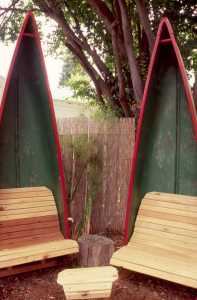

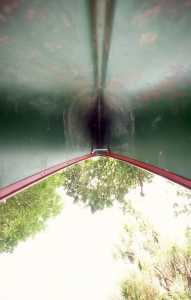
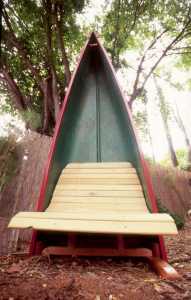
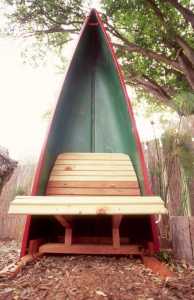
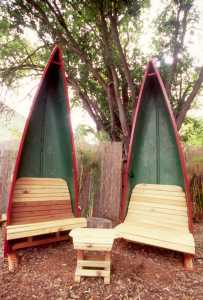
You probably notice that the two chairs are slightly different. The one on the left reclines 15 Degrees from the vertical and the seat is at right angles to the back. The one on the right reclines 20 degrees from the vertical and the seat is horizontal. The one on the right is the more comfortable geometry.
When you sit on the seats you’ll notice how solid they are. There’s a slight wiggle to the Canoe Half, which is OK since it’s not structural, but the Seat and Base are solid.
|
Resources:
This was a low cost project, mainly because the wood was salvaged and scavenged. The other side of that equation, of course, is the inordinate amount of work required to rehabilitate old wood, from removing nails to planning 1/16th inch off the sides to show good wood underneath.
- Canoe: Donated by our good friend and neighbour Peter
- Base and Seat Frame: Old 2x4s salvaged from a remodeling job in Berkeley and acquired through Craig’s List
- Seat Surface: Mainly Cedar from siding salvaged from a 100 year old church in Ashland and acquired through Craig’s List
All photographs © Neil Robertson, all right reserved.
|